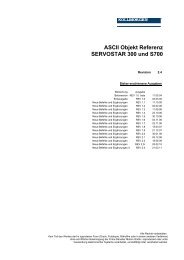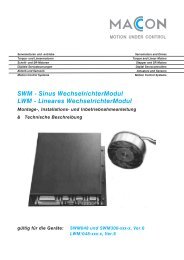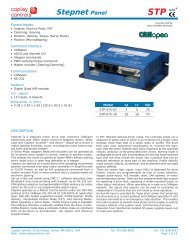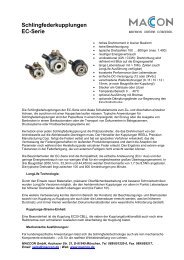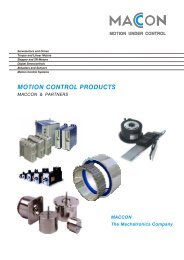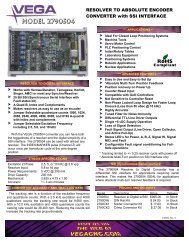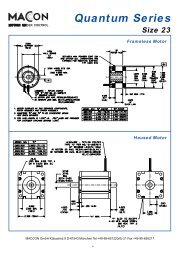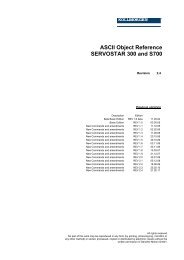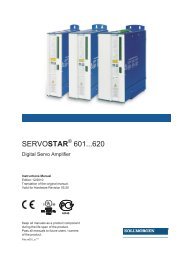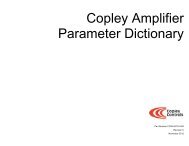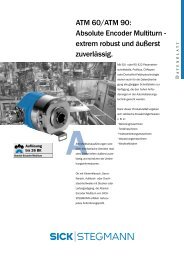CANopen Programmer's Manual - Maccon.de
CANopen Programmer's Manual - Maccon.de
CANopen Programmer's Manual - Maccon.de
You also want an ePaper? Increase the reach of your titles
YUMPU automatically turns print PDFs into web optimized ePapers that Google loves.
<strong>CANopen</strong> Programmer’s <strong>Manual</strong> 5: Stepper Mo<strong>de</strong> Support<br />
5.1: Stepper Mo<strong>de</strong> Operation<br />
Copley Controls Amplifiers and Stepper Mo<strong>de</strong> Operation<br />
Copley Controls supports the use of stepper motors over a <strong>CANopen</strong> network.<br />
The Stepnet amplifier can drive a two-phase stepper motor in stepper or servo mo<strong>de</strong>.<br />
The Accelnet and Xenus amplifiers can drive a three-phase stepper motor in stepper mo<strong>de</strong>.<br />
Stepper vs. Servo<br />
In a closed-loop servo system, sensors feed back the actual position and/or velocity of the motor,<br />
and the amplifier calculates how much torque to apply to the motor to move it to the target<br />
<strong>de</strong>stination.<br />
An open-loop stepper system does not typically have sensors to feed back actual position or<br />
velocity information. Nor does it use the position and velocity loops used in servo systems.<br />
Instead, the amplifier moves the motor in steps by applying fixed current to the motor’s windings in<br />
measured intervals. Position and velocity commands can be <strong>de</strong>rived but not measured.<br />
Microstepping<br />
The type of stepper motor supported by the Copley Controls Stepnet amplifier has two windings. It<br />
can be driven using the simple full stepping method or the more precise microstepping method.<br />
Copley Controls supports microstepping as <strong>de</strong>scribed in Microstepping (p. 159).<br />
The Accelnet and Xenus amplifiers support three-phase, three-winding stepper motors. The<br />
Accelnet and Xenus also use microstepping to drive these three-phase stepper motors.<br />
Microstepping<br />
Copley Controls’ microstepping amplifiers provi<strong>de</strong> a much higher <strong>de</strong>gree of control over a motor’s<br />
position than does a full stepping system. The microstepping amplifier applies varying amounts of<br />
current into both windings of the motor at the same time, making it possible to rest the motor not<br />
only at the full step locations, but at points between them, and thus allowing a high <strong>de</strong>gree of<br />
control over the motor’s position.<br />
In microstepping mo<strong>de</strong> it is necessary to program the following <strong>CANopen</strong> objects:<br />
Object Description<br />
Motor Pole Pairs<br />
(In<strong>de</strong>x 0x2383, Sub-In<strong>de</strong>x 2, p. 91)<br />
Microsteps/Rev<br />
(In<strong>de</strong>x 0x2383, Sub-In<strong>de</strong>x 29, p. 96)<br />
Number of motor pole pairs (electrical phases) per rotation. For example, for<br />
a 1.8 <strong>de</strong>g/step motor, set Motor Pair Polls to 50.<br />
Microsteps per revolution.<br />
There is virtually no limit on the number of microsteps/rev. Programming a very high value does<br />
not mean that the amplifier can actually move the motor to that many distinct positions, because<br />
the ability to control current in the windings is limited. The practical limit <strong>de</strong>pends on the motor, but<br />
something on the or<strong>de</strong>r of 1000 microsteps/electrical cycle is generally reasonable. It is<br />
sometimes advantageous to program a large number of microsteps, so the system works as<br />
expected when connected to a high resolution enco<strong>de</strong>r.<br />
Some drive manufacturers require that the number of microsteps/rev be an integer multiple of the<br />
number of electrical cycles. Copley Controls amplifiers do not have such a limitation.<br />
Copley Controls 159




